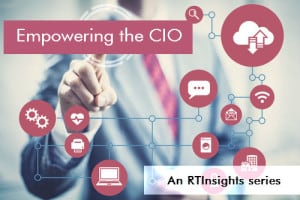
To innovate with IT data, you first need all the data.
In part two of our “Empowering the CIO” series, Rocana’s CEO, Omer Trajman, talks about how obtaining a single view of IT data helps companies innovate and achieve operational efficiency.
Transcript:
Adrian: Hi, I’m Adrian Bowles with RT Insights and Storm Insights. We conduct ongoing research into the opportunities and challenges presented by new technologies and the day-to-day issues facing CIOs as they attempt to get the most out of their technology investments. In this series, we asked executives of emerging innovative technology firms how they address specific issues that today’s CIOs struggle with everyday. Today’s guest is the CEO and co-founder of Rocana.
CIOs face two pressure points that often seem to be in conflict. They have to run an operationally efficient cost center and today they’re also expected to contribute to the business vision. For example, businesses in all industries seem to want to provide a personalized customer experience based on analytics. That often means they have to provide a mobile front end that can wreak havoc with data center performance, but CIOs have to innovate and deliver these systems, a great business value. What will help us re-balance these pressure points of low cost operational efficiency and innovation?
Omer: It’s a very interesting challenge because while IT budgets are actually increasing year over year, if you look at industry surveys, they are decreasing relative to the complexity and the requirements being put on IT. It used to be that IT was a back-end support function where it served people at the company who interacted with customers. Now, today customers interact with IT systems. That means that the SLAs go up, that means that the complexity of the systems go up, and the budget dollars being spent on IT is not increasing at a rate to match that.
The scenario that IT is in, is that if they’re using legacy approaches to monitor and operate, which is silos of individual perspectives where I look at the website separate from the network but separate from the application server. That worked back when you were supporting people. That doesn’t work anymore when you’re supporting a digital company. What Rocana helps CIOs do is actually re-think how they’re operating end-to-end. It turns out that the ability to run efficiently using data collected from all of these systems end-to-end and looking at them in one place, that’s one side of the coin of innovation which is using all that data to understand how do people interact.
By collecting all the data and looking at the details of how customers interact — they’re not interacting with people, they’re interacting with systems and machines. You can operate that more efficiently if you look at the date of the interaction, and it’ll give you insight on how to innovate and how to improve those interactions, again, because you have data about those interactions. The key is you’re looking at all that data in one place, that’s really what Rocana is enabling at the end of the day.
Adrian: Thanks, Omar, and thank you for watching. For more information on Rocana, please visit their website at rocana.com. To see more videos in this series, please visit rtinsights.com.





























